Effect of Effluent Recirculation on the Performance of an Anaerobic Baffled Reactor in Municipal Wastewater Treatment: A Modeling Approach
Abstract
1. Introduction
2. Materials and Methods
2.1. Apparatus
2.2. Wastewater Composition
2.3. Inoculum and Seeding
2.4. Sampling and Analysis
2.5. Operation of the ABR
2.6. Modeling
2.6.1. Model Development
2.6.2. Influent Data Adjustment
2.6.3. Model Operating Conditions
2.6.4. Sensitivity Analysis
- i.
- Anoxic heterotrophic yield on soluble substrate (yhanocon);
- ii.
- Maximum specific growth rate of heterotrophic biomass on substrate (μhcon);
- iii.
- Anaerobic reduction factor for decay rate of heterotrophic biomass (nanaerxbhcon);
- iv.
- Maximum fermentation rate (qfecon).
2.6.5. Model Simulation
2.6.6. Model-Based Predictions of COD and TSS Removal Across Various Effluent RRs
3. Results and Discussion
3.1. Effluent-Measured COD and TSS Concentrations at Steady-State Operation
3.2. Model Calibration
3.2.1. Adjustment of Input Parameters
3.2.2. Calibration Results
3.3. Model Validation
3.4. Model Compartment-Level COD Concentrations
3.5. Effect of Effluent Recirculation on COD and TSS Removal Performance
3.5.1. Effect on COD Removal Performance
3.5.2. Effect on TSS Removal Performance
3.6. Comparison of COD Removal Efficiency and the Influence of Influent COD and HRT
4. Conclusions
Author Contributions
Funding
Institutional Review Board Statement
Informed Consent Statement
Data Availability Statement
Conflicts of Interest
References
- Ungureanu, N.; Vlăduț, V.; Voicu, G. Water Scarcity and Wastewater Reuse in Crop Irrigation. Sustainability 2020, 12, 9055. [Google Scholar] [CrossRef]
- Jones, E.R.; Van Vliet, M.T.H.; Qadir, M.; Bierkens, M.F.P. Spatially-explicit estimates of global wastewater production, collection, treatment and re-use. Earth Syst. Sci. Data Discuss. 2020. [Google Scholar] [CrossRef]
- Cossio, C.; Norrman, J.; McConville, J.; Mercado, A.; Rauch, S. Indicators for sustainability assessment of small-scale wastewater treatment plants in low and lower-middle income countries. Environ. Sustain. Indic. 2020, 6, 100028. [Google Scholar] [CrossRef]
- Oliveira, G.A.; Colares, G.S.; Lutterbeck, C.A.; Dell’Osbel, N.; Machado, Ê.L.; Rodrigues, L.R. Floating treatment wetlands in domestic wastewater treatment as a decentralized sanitation alternative. Sci. Total. Environ. 2021, 773, 145609. [Google Scholar] [CrossRef]
- Chowdhury, S.D.; Bhunia, P.; Surampalli, R.Y. Sustainability assessment of vermifiltration technology for treating domestic sewage: A review. J. Water Process. Eng. 2022, 50, 103266. [Google Scholar] [CrossRef]
- del Castillo, A.F.; Garibay, M.V.; Senés-Guerrero, C.; Orozco-Nunnelly, D.A.; de Anda, J.; Gradilla-Hernández, M.S. A review of the sustainability of anaerobic reactors combined with constructed wetlands for decentralized wastewater treatment. J. Clean. Prod. 2022, 371, 133428. [Google Scholar] [CrossRef]
- Lourenço, N.; Nunes, L.M. Review of Dry and Wet Decentralized Sanitation Technologies for Rural Areas: Applicability, Challenges and Opportunities. Environ. Manage 2020, 65, 642–664. [Google Scholar] [CrossRef]
- Atanasova, N.; Castellar, J.A.; Pineda-Martos, R.; Nika, C.E.; Katsou, E.; Istenič, D.; Pucher, B.; Andreucci, M.B.; Langergraber, G. Nature-Based Solutions and Circularity in Cities. Circ. Econ. Sustain. 2021, 1, 319–332. [Google Scholar] [CrossRef]
- Daee, M.; Gholipour, A.; Stefanakis, A.I. Performance of pilot Horizontal Roughing Filter as polishing stage of waste stabilization ponds in developing regions and modelling verification. Ecol. Eng. 2019, 138, 8–18. [Google Scholar] [CrossRef]
- Sayedin, F.; Kermanshahi-pour, A.; He, Q.S. Evaluating the potential of a novel anaerobic baffled reactor for anaerobic digestion of thin stillage: Effect of organic loading rate, hydraulic retention time and recycle ratio. Renew. Energy 2019, 135, 975–983. [Google Scholar] [CrossRef]
- Lau, P.L.; Trzcinski, A.P. A review of modified and hybrid anaerobic baffled reactors for municipal wastewater treatment with a focus on emerging contaminants. Environ. Sci. 2024, 10, 1335–1354. [Google Scholar] [CrossRef]
- Aris, M.A.M.; Chelliapan, S.; Din, M.F.M.; Anwar, A.N.; Shahperi, R.; Selvam, S.B. Effect of effluent circulation and hydraulic retention time (HRT) on the performance of a modified anaerobic baffled reactor (MABR) during start-up period. Desalination Water Treat. 2016, 57, 18597–18605. [Google Scholar] [CrossRef]
- Vuitik, G.A.; Fuess, L.T.; Del Nery, V.; Bañares-Alcántara, R.; Pires, E.C. Effects of recirculation in anaerobic baffled reactors. J. Water Process Eng. 2019, 28, 36–44. [Google Scholar] [CrossRef]
- Nabaterega, R.; Kumar, V.; Khoei, S.; Eskicioglu, C. A review on two-stage anaerobic digestion options for optimizing municipal wastewater sludge treatment process. J. Environ. Chem. Eng. 2021, 9, 105502. [Google Scholar] [CrossRef]
- Ban, Q.; Li, J.; Zhang, L.; Jha, A.K.; Nies, L. Linking Performance with Microbial Community Characteristics in an Anaerobic Baffled Reactor. Appl. Biochem. Biotechnol. 2013, 169, 1822–1836. [Google Scholar] [CrossRef]
- Srivastava, S.; Brar, S.K.; Rao, S.; Kumar, P. Assessing operational issues in a modular sewage treatment plant and providing remedies via comprehensive modeling and simulation through GPS-X. J. Water Process Eng. 2024, 57, 104678. [Google Scholar] [CrossRef]
- Cruz, I.A.; Chuenchart, W.; Long, F.; Surendra, K.; Andrade, L.R.S.; Bilal, M.; Liu, H.; Figueiredo, R.T.; Khanal, S.K.; Ferreira, L.F.R. Application of machine learning in anaerobic digestion: Perspectives and challenges. Bioresour. Technol. 2022, 345, 126433. [Google Scholar] [CrossRef]
- Xie, Y.; Chen, Y.; Lian, Q.; Yin, H.; Peng, J.; Sheng, M.; Wang, Y. Enhancing Real-Time Prediction of Effluent Water Quality of Wastewater Treatment Plant Based on Improved Feedforward Neural Network Coupled with Optimization Algorithm. Water 2022, 14, 1053. [Google Scholar] [CrossRef]
- Golzar, F.; Nilsson, D.; Martin, V. Forecasting Wastewater Temperature Based on Artificial Neural Network (ANN) Technique and Monte Carlo Sensitivity Analysis. Sustainability 2020, 12, 6386. [Google Scholar] [CrossRef]
- Li, S.; Nan, J.; Gao, F. Hydraulic characteristics and performance modeling of a modified anaerobic baffled reactor (MABR). Chem. Eng. J. 2016, 284, 85–92. [Google Scholar] [CrossRef]
- Jasim, N.A. The design for wastewater treatment plant (WWTP) with GPS-X modelling. Cogent Eng. 2020, 7, 1723782. [Google Scholar] [CrossRef]
- Nasr, M.S.; Moustafa, M.A.E.; Seif, H.A.E.; El Kobrosy, G. Modelling and simulation of German BIOGEST/EL-AGAMY wastewater treatment plants—Egypt using GPS-X simulator. Alex. Eng. J. 2011, 50, 351–357. [Google Scholar] [CrossRef]
- Mu’azu, N.D.; Alagha, O.; Anil, I. Systematic Modeling of Municipal Wastewater Activated Sludge Process and Treatment Plant Capacity Analysis Using GPS-X. Sustainability 2020, 12, 8182. [Google Scholar] [CrossRef]
- Ullah, N.; Sheikh, Z.; Badshah, M. Municipal wastewater treatment with corrugated PVC carrier anaerobic baffled reactor. Water Sci. Technol. 2023, 87, 660–671. [Google Scholar] [CrossRef]
- Maryam, A.; Zeshan; Badshah, M.; Sabeeh, M.; Khan, S.J. Enhancing methane production from dewatered waste activated sludge through alkaline and photocatalytic pretreatment. Bioresour. Technol. 2021, 325, 124677. [Google Scholar] [CrossRef]
- APHA. Standard Methods for the Examination of Water and Wastewater, 23rd ed.; American Public Health Association: Washington, DC, USA, 2017. [Google Scholar]
- Zha, X.; Ma, J.; Tsapekos, P.; Lu, X. Evaluation of an anaerobic baffled reactor for pretreating black water: Potential application in rural China. J. Environ. Manage 2019, 251, 109599. [Google Scholar] [CrossRef]
- Aqanaghad, M.; Mousavi, G.; Ghanbari, R. Anaerobic Baffled Reactor and Hybrid Anaerobic Baffled Reactor Performances Evaluation in Municipal Wastewater Treatment. Iran. J. Health Saf. Environ. 2018, 5, 1027–1034. [Google Scholar]
- Hydromantis. 2019. Available online: https://www.hydromantis.com/help/GPS-X/docs/8.0/Technical/index.html (accessed on 20 December 2024).
- Faris, A.M.; Zwain, H.M.; Hosseinzadeh, M.; Majdi, H.S.; Siadatmousavi, S.M. Start-up and operation of novel EN-MBBR system for sidestreams treatment and sensitivity analysis modeling using GPS-X simulation. Alex. Eng. J. 2022, 61, 10805–10818. [Google Scholar] [CrossRef]
- Moghaddam, S.S.; Pirali, M. Modeling and calibration of a full-scale wastewater treatment plant using GPS-X model (A case study of Tehran). Numer. Methods Civ. Eng. 2021, 5, 67–76. [Google Scholar] [CrossRef]
- Ji, X.; Liu, Y.; Zhang, J.; Huang, D.; Zhou, P.; Zheng, Z. Development of model simulation based on BioWin and dynamic analyses on advanced nitrate nitrogen removal in deep bed denitrification filter. Bioprocess Biosyst. Eng. 2019, 42, 199–212. [Google Scholar] [CrossRef]
- Hellal, M.S.; Abou-Elela, S.I. Simulation of a passively aerated biological filter (PABF) immobilized with non-woven polyester fabric (NWPF) for wastewater treatment using GPS-X. Water Environ. J. 2021, 35, 1192–1203. [Google Scholar] [CrossRef]
- Donoso-Bravo, A.; Mailier, J.; Martin, C.; Rodríguez, J.; Aceves-Lara, C.A.; Wouwer, A.V. Model selection, identification and validation in anaerobic digestion: A review. Water Res. 2011, 45, 5347–5364. [Google Scholar] [CrossRef] [PubMed]
- Cao, J.; Yang, E.; Xu, C.; Zhang, T.; Xu, R.; Fu, B.; Feng, Q.; Fang, F.; Luo, J. Model-based strategy for nitrogen removal enhancement in full-scale wastewater treatment plants by GPS-X integrated with response surface methodology. Sci. Total Environ. 2021, 769, 144851. [Google Scholar] [CrossRef] [PubMed]
- Herrera-Melián, J.A.; Guedes-Alonso, R.; Tite-Lezcano, J.C.; Santiago, D.E.; Ranieri, E.; Alonso-Bilbao, I. The Effect of Effluent Recirculation in a Full-Scale Constructed Wetland System. Sustainability 2023, 15, 4310. [Google Scholar] [CrossRef]
- Nasr, F.A.; Doma, H.S.; Nassar, H.F. Treatment of domestic wastewater using an anaerobic baffled reactor followed by a duckweed pond for agricultural purposes. Environmentalist 2009, 29, 270–279. [Google Scholar] [CrossRef]
- Mahdi, F.K.; Abu-Alhail, S.; Dawood, A.S. Performance of the anaerobic baffled reactor for primary treatment of rural domestic wastewater in Iraq. Open Eng. 2022, 12, 859–865. [Google Scholar] [CrossRef]
- Tilley, E.A.; Ulrich, L.; Luthi, C.; Reymond, P. Compendium of Sanitation Systems and Technologies. 2014. Available online: https://www.researchgate.net/publication/283072433 (accessed on 6 February 2025).
- Morel, A.; Diener, S. Greywater Management in Low and Middle-Income Countries: Review of Different Treatment Systems for Households or Neighbourhoods. Swiss Federal Institute of Aquatic Science and Technology: Duebendorf, Switzerland, 2006; Available online: https://www.susana.org/en/knowledge-hub/resources-and-publications/library/details/947 (accessed on 6 March 2025).
- Liwarska-Bizukojc, E.; Biernacki, R. Identification of the most sensitive parameters in the activated sludge model implemented in BioWin software. Bioresour. Technol. 2010, 101, 7278–7285. [Google Scholar] [CrossRef]
- Reynaud, N.; Buckley, C.A. The anaerobic baffled reactor (ABR) treating communal wastewater under mesophilic conditions: A review. Water Sci. Technol. 2016, 73, 463–478. [Google Scholar] [CrossRef]
- Liwarska-Bizukojc, E.; Olejnik, D.; Biernacki, R.; Ledakowicz, S. Calibration of a complex activated sludge model for the full-scale wastewater treatment plant. Bioprocess Biosyst. Eng. 2011, 34, 659–670. [Google Scholar] [CrossRef]
- Elawwad, A.; Matta, M.; Abo-Zaid, M.; Abdel-Halim, H. Plant-wide modeling and optimization of a large-scale WWTP using BioWin’s ASDM model. J. Water Process Eng. 2019, 31, 100819. [Google Scholar] [CrossRef]
- Manariotis, I.D.; Grigoropoulos, S.G. Low-Strength Wastewater Treatment Using an Anaerobic Baffled Reactor. Water Environ. Res. 2002, 74, 170–176. [Google Scholar] [CrossRef] [PubMed]
- Krishna, G.V.T.G.; Kumar, P.; Kumar, P. Treatment of low-strength soluble wastewater using an anaerobic baffled reactor (ABR). J. Environ. Manage 2009, 90, 166–176. [Google Scholar] [CrossRef] [PubMed]
- Yenji, S.S.; Munavalli, G.R.; Koli, M.M. Field-scale anaerobic baffled reactor for domestic wastewater treatment: Effect of dynamic operating conditions. Water Pract. Technol. 2021, 16, 42–58. [Google Scholar] [CrossRef]
- Aqaneghad, M.; Moussavi, G. Electrochemically enhancement of the anaerobic baffled reactor performance as an appropriate technology for treatment of municipal wastewater in developing countries. Sustain. Environ. Res. 2016, 26, 203–208. [Google Scholar] [CrossRef]
- Sun, H.; Yu, N.; Mou, A.; Yang, X.; Liu, Y. Effluent recirculation weakens the hydrolysis of high-solid content feeds in upflow anaerobic sludge blanket reactors. J. Environ. Chem. Eng. 2022, 10, 107913. [Google Scholar] [CrossRef]
- Zhang, L.; Guo, B.; Mou, A.; Li, R.; Liu, Y. Blackwater biomethane recovery using a thermophilic upflow anaerobic sludge blanket reactor: Impacts of effluent recirculation on reactor performance. J. Environ. Manage 2020, 274, 111157. [Google Scholar] [CrossRef]
- Chow, W.L.; Chong, S.; Lim, J.W.; Chan, Y.J.; Chong, M.F.; Tiong, T.J.; Chin, J.K.; Pan, G.-T. Anaerobic Co-Digestion of Wastewater Sludge: A Review of Potential Co-Substrates and Operating Factors for Improved Methane Yield. Processes 2020, 8, 39. [Google Scholar] [CrossRef]
- Sarathai, Y.; Koottatep, T.; Morel, A. Hydraulic characteristics of an anaerobic baffled reactor as onsite wastewater treatment system. J. Environ. Sci. 2010, 22, 1319–1326. [Google Scholar] [CrossRef]
- Zhu, G.-F.; Li, J.-Z.; Wu, P.; Jin, H.-Z.; Wang, Z. The performance and phase separated characteristics of an anaerobic baffled reactor treating soybean protein processing wastewater. Bioresour. Technol. 2008, 99, 8027–8033. [Google Scholar] [CrossRef]
- Grobicki, A.; Stuckey, D.C. Hydrodynamic characteristics of the anaerobic baffled reactor. Water Res. 1992, 26, 371–378. [Google Scholar] [CrossRef]
- Kariyama, I.D.; Zhai, X.; Wu, B. Influence of mixing on anaerobic digestion efficiency in stirred tank digesters: A review. Water Res. 2018, 143, 503–517. [Google Scholar] [CrossRef] [PubMed]
- Santos, F.S.; Ricci, B.C.; Neta, L.S.F.; Amaral, M.C.S. Sugarcane vinasse treatment by two-stage anaerobic membrane bioreactor: Effect of hydraulic retention time on changes in efficiency, biogas production and membrane fouling. Bioresour. Technol. 2017, 245, 342–350. [Google Scholar] [CrossRef] [PubMed]
- Dharsika, N.; Raj, S.A.; Mohan, S.M. Hydrodynamic behaviour and treatment performance of the hybrid anaerobic baffled reactor. Desalination Water Treat. 2022, 268, 1–11. [Google Scholar] [CrossRef]
- Yurtsever, A.; Calimlioglu, B.; Sahinkaya, E. Impact of SRT on the efficiency and microbial community of sequential anaerobic and aerobic membrane bioreactors for the treatment of textile industry wastewater. Chem. Eng. J. 2017, 314, 378–387. [Google Scholar] [CrossRef]
- Nguyen; Ha, T.D.; Morel, A.; Moura, M. Decentralised wastewater treatment—New concepts and technologies for Vietnamese conditions. In Proceedings of the 2nd International Symposium on Ecological Sanitation, Lübeck, Germany, 7–11 April 2003. [Google Scholar]
- Chen, Y.; Shen, Y. Operational characteristics of anaerobic baffled reactor treating low strength wastewater. J. Univ. Sci. Technol. Suzhou (Eng. Technol.) 2006, 19, 35–38. [Google Scholar]
- Foxon, K.M. Analysis of a Pilot-Scale Anaerobic Baffled Reactor Treating Domestic Wastewater. Ph.D. Thesis, University of KwaZulu-Natal, Durban, South Africa, 2009. [Google Scholar]
- Reynaud, N. Operation of Decentralised Wastewater Treatment Systems (DEWATS) Under Tropical Field Conditions. Ph.D. Thesis, Technical University Dresden, Dresden, South Africa, 2015. [Google Scholar]
- Munavalli, G.R.; Sonavane, P.G.; Koli, M.M.; Dhamangaokar, B.S. Field-scale decentralized domestic wastewater treatment system: Effect of dynamic loading conditions on the removal of organic carbon and nitrogen. J. Environ. Manage 2022, 302, 114014. [Google Scholar] [CrossRef]
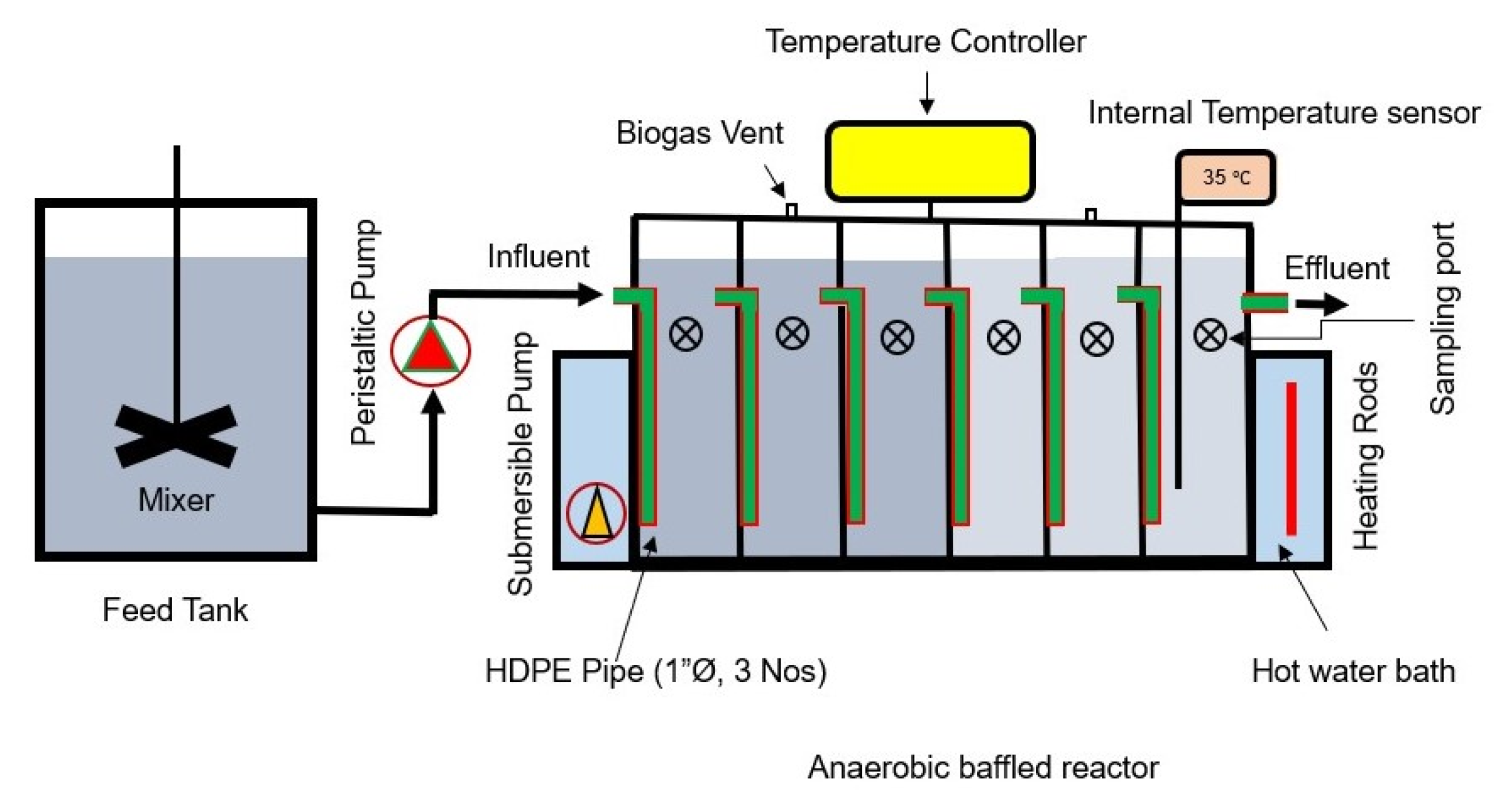

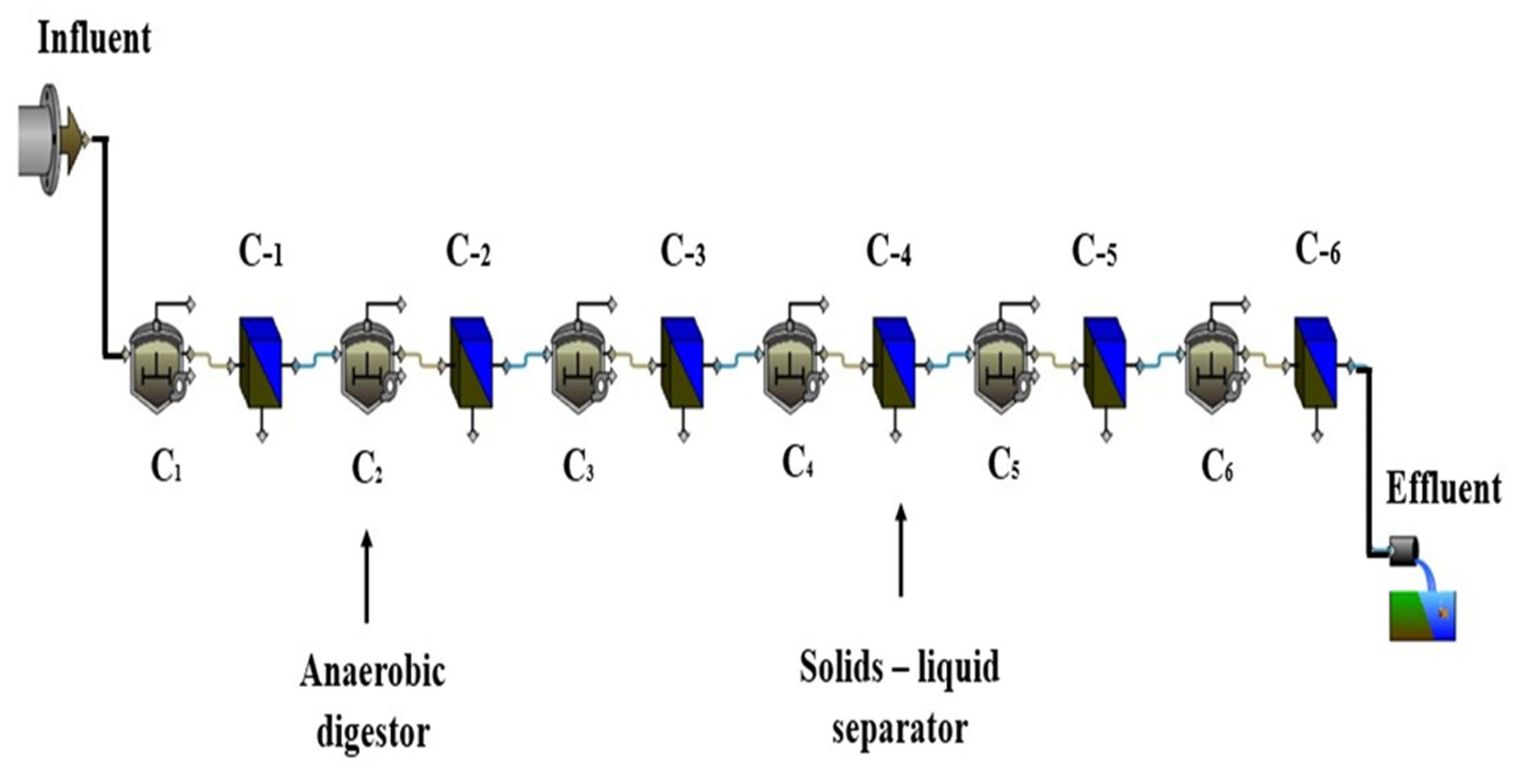
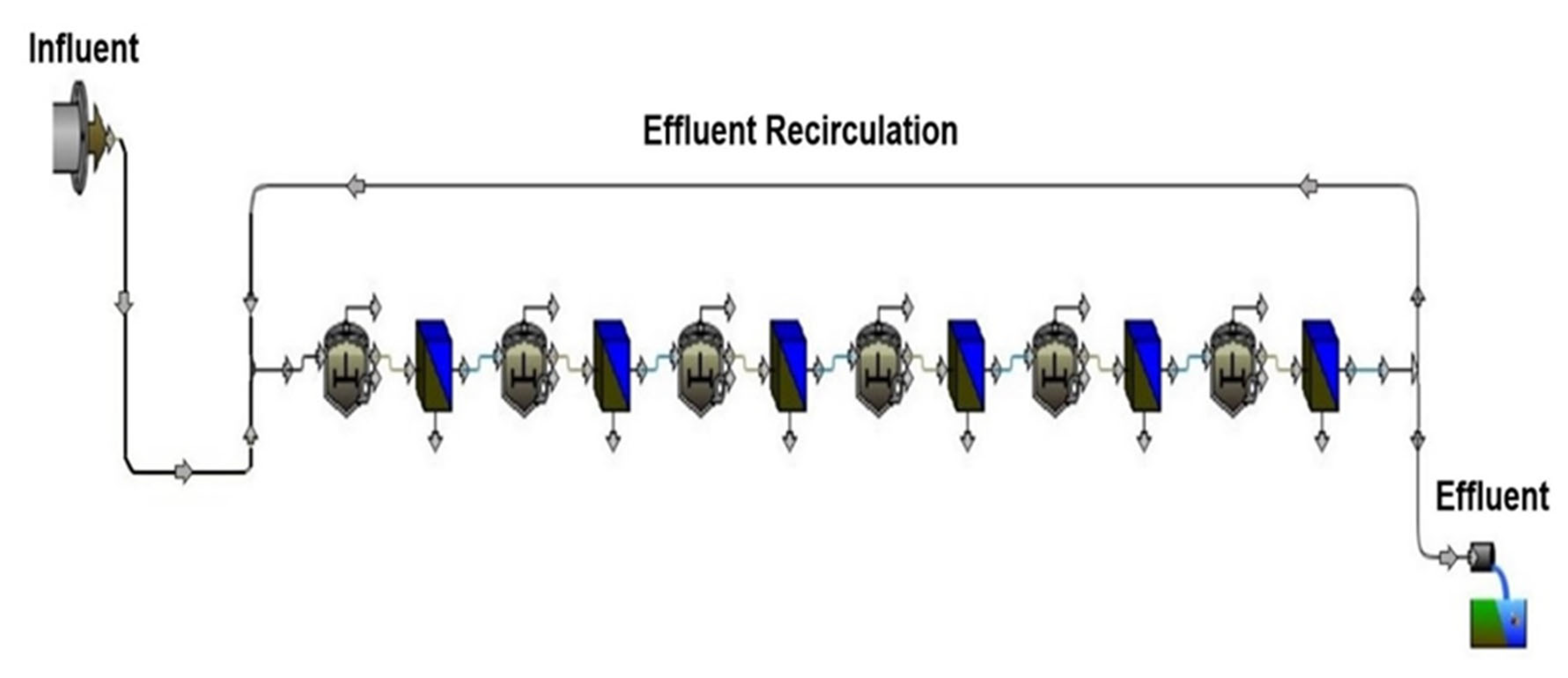
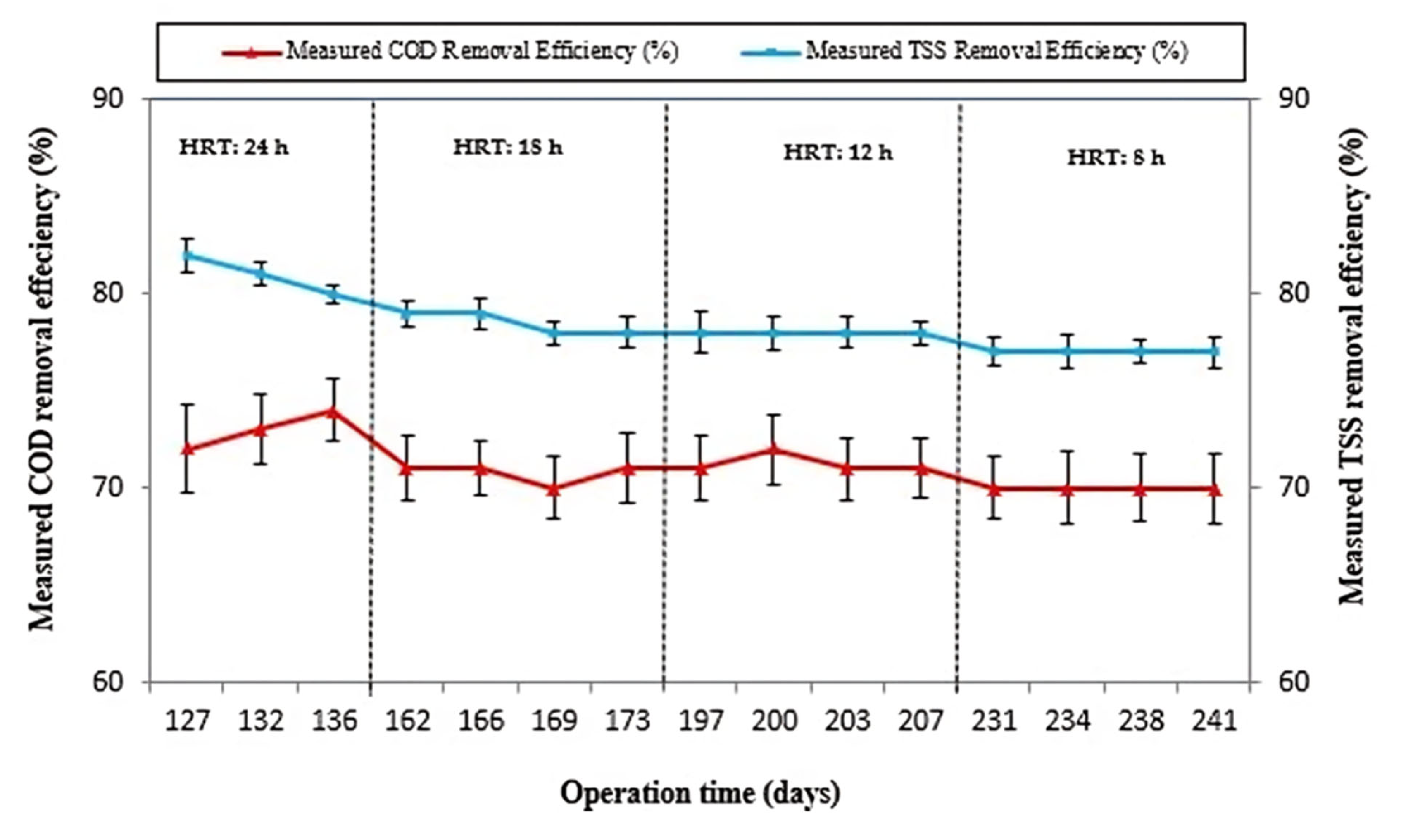

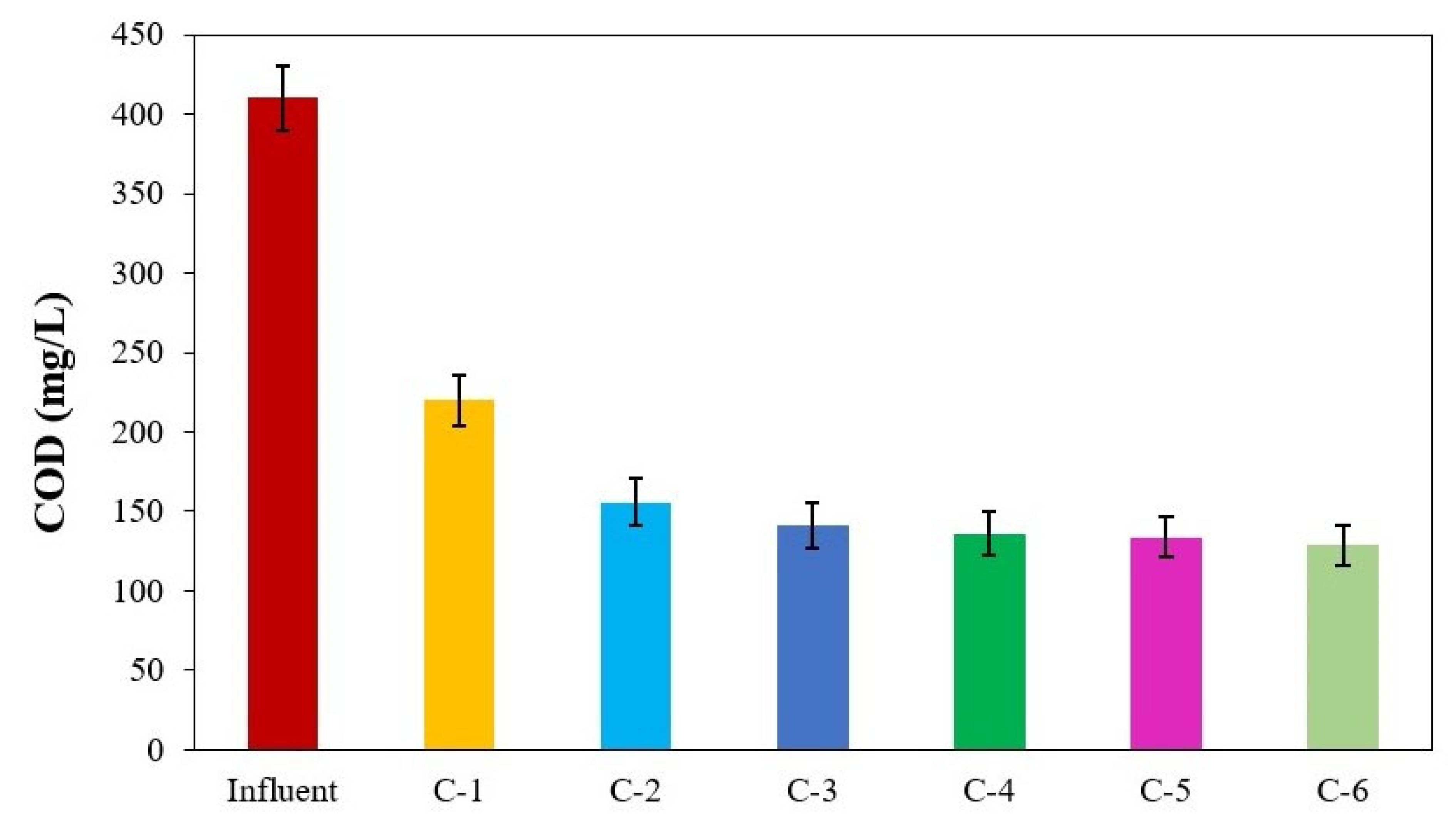

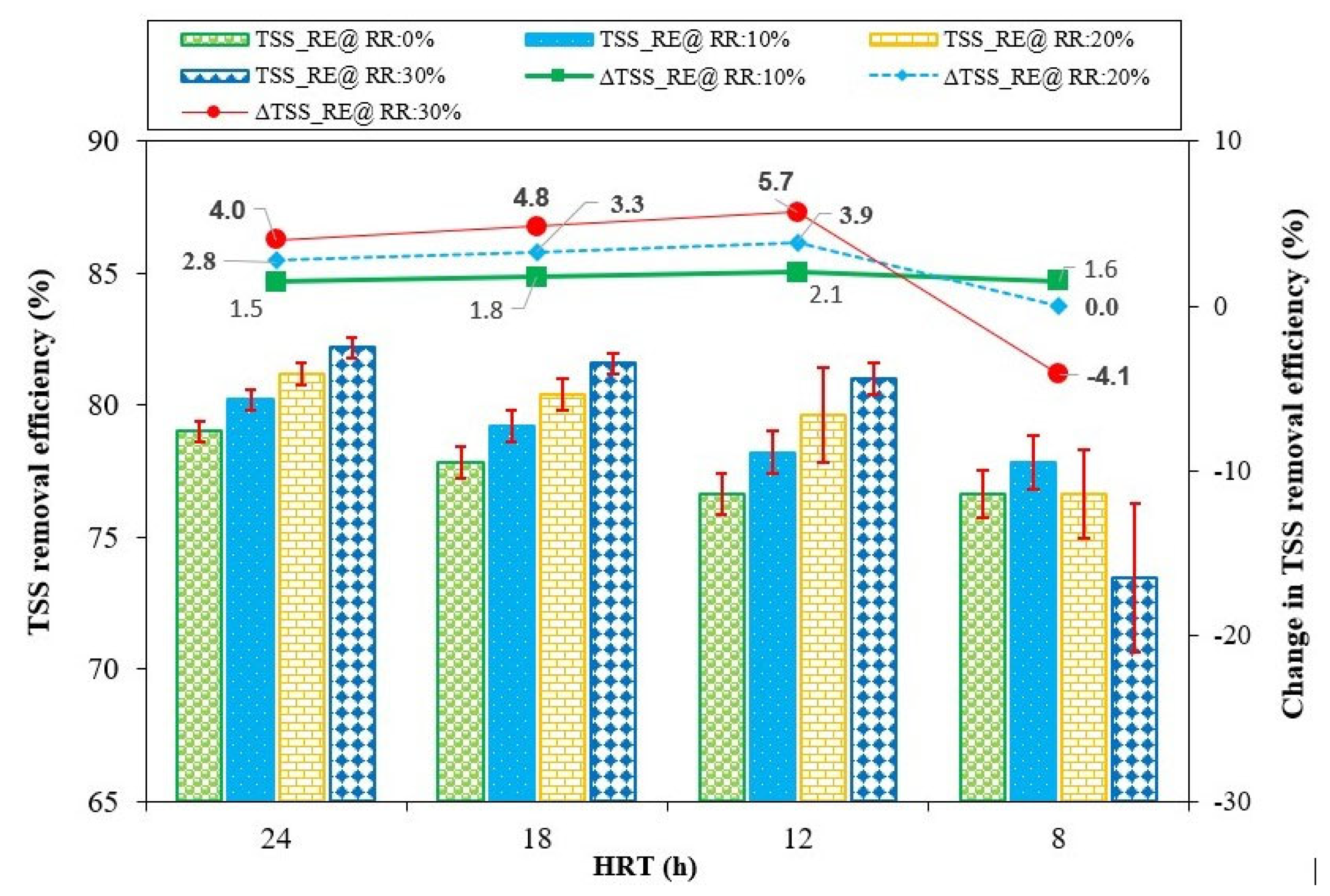
| Start-up Phase Operating Conditions in Batch Mode | ||
|---|---|---|
| HRT (d) | Initial COD (mg/L) | Operation Duration (d) |
| 90 | 1129 | 90 |
| Operating Conditions in Continuous-Flow Mode | ||
| HRT (h) | Influent Flow (L/hour) | Operation Duration (d) |
| 24 | 1 | 46 |
| 18 | 1.3 | 37 |
| 12 | 2 | 32 |
| 8.0 | 3 | 32 |
| Parameter | Default Value | Adjusted Value |
|---|---|---|
| Total COD (gCOD/m3) | 430 | 414.5 ± 36.5 |
| Total suspended solids (gCOD/m3) | 225 | 50.5 |
| Total inorganic suspended solids (gCOD/m3) | 56.1 | 40.4 |
| Volatile suspended solids (gCOD/m3) | 168.4 | 10.1 |
| VSS/TSS ratio (gVSS/gTSS) | 0.75 | 0.20 |
| Operation Time (Days) | HRT (h) | Influent Flow Rate (L/h) | Influent COD (mg/L) |
|---|---|---|---|
| 127 | 24 | 1.0 | 386 |
| 132 | 438 | ||
| 136 | 432 | ||
| 162 | 18 | 1.33 | 412 |
| 166 | 398 | ||
| 169 | 387 | ||
| 173 | 418 | ||
| 197 | 12 | 2.0 | 396 |
| 200 | 425 | ||
| 203 | 434 | ||
| 207 | 451 | ||
| 231 | 8 | 3.0 | 412 |
| 234 | 398 | ||
| 238 | 378 | ||
| 241 | 392 |
| Parameter | Unit | Compartment | Default Value | Adjusted Value |
|---|---|---|---|---|
| Anoxic heterotrophic yield on soluble substrate (yhanocon) | gCOD/gCOD | C1 | 0.533 | 0.55 |
| Maximum specific growth rate of heterotrophic biomass on substrate (μhcon) | 1/d | C1 | 3.2 | 13.5 |
| C2 | 3.70 | |||
| C3 | 3.70 | |||
| C4 | 3.68 | |||
| C5 | 2.2 | |||
| C6 | 1.97 | |||
| Anaerobic reduction factor for decay rate of heterotrophic biomass (nanaerxbhcon) | % | C1 | 60.0 | 41.0 |
| C2 | 41.0 | |||
| C3 | 41.0 | |||
| C4 | 41.0 | |||
| C5 | 41.0 | |||
| C6 | 41.0 | |||
| Maximum fermentation rate(qfecon) | 1/d | C1 | 3.0 | 12.0 |
| C2 | 3.13 | |||
| C3 | 2.98 | |||
| C4 | 2.8 | |||
| C5 | 2.60 | |||
| C6 | 2.40 |
| Substrate | Influent COD (mg/L) | HRT (h) | Effluent COD (mg/L) | COD Removal Efficiency (%) | References |
|---|---|---|---|---|---|
| Black water | 500 | 84 | 180 | 64 | [59] |
| 1 Dom. WW | 500 | 3–12 | 50–70 | 85–90 | [60] |
| 2 Syn. WW | 680 | 8–24 | 105–227 | 67–85 | [37] |
| Dom. WW | 367–390 | 22–42 | 67–121 | 69–81 | [61] |
| Dom. WW | 224 | 49 | 127 | 43 | [62] |
| Dom. WW | 403–424 | 24–55 | 258–287 | 29–39 | [63] |
| Syn. WW | 410 | 12 | 124 | 70 | This study |
| Syn. WW | 410 | 8.0 | 144 | 65 | This study |
Disclaimer/Publisher’s Note: The statements, opinions and data contained in all publications are solely those of the individual author(s) and contributor(s) and not of MDPI and/or the editor(s). MDPI and/or the editor(s) disclaim responsibility for any injury to people or property resulting from any ideas, methods, instructions or products referred to in the content. |
© 2025 by the authors. Licensee MDPI, Basel, Switzerland. This article is an open access article distributed under the terms and conditions of the Creative Commons Attribution (CC BY) license (https://creativecommons.org/licenses/by/4.0/).
Share and Cite
Ullah, N.; Sheikh, Z.; Alotaibi, S.B.; Khan, M.; Ahmad, A. Effect of Effluent Recirculation on the Performance of an Anaerobic Baffled Reactor in Municipal Wastewater Treatment: A Modeling Approach. Sustainability 2025, 17, 3783. https://doi.org/10.3390/su17093783
Ullah N, Sheikh Z, Alotaibi SB, Khan M, Ahmad A. Effect of Effluent Recirculation on the Performance of an Anaerobic Baffled Reactor in Municipal Wastewater Treatment: A Modeling Approach. Sustainability. 2025; 17(9):3783. https://doi.org/10.3390/su17093783
Chicago/Turabian StyleUllah, Nadeem, Zeshan Sheikh, Sarah Bader Alotaibi, Mujahid Khan, and Aziz Ahmad. 2025. "Effect of Effluent Recirculation on the Performance of an Anaerobic Baffled Reactor in Municipal Wastewater Treatment: A Modeling Approach" Sustainability 17, no. 9: 3783. https://doi.org/10.3390/su17093783
APA StyleUllah, N., Sheikh, Z., Alotaibi, S. B., Khan, M., & Ahmad, A. (2025). Effect of Effluent Recirculation on the Performance of an Anaerobic Baffled Reactor in Municipal Wastewater Treatment: A Modeling Approach. Sustainability, 17(9), 3783. https://doi.org/10.3390/su17093783














